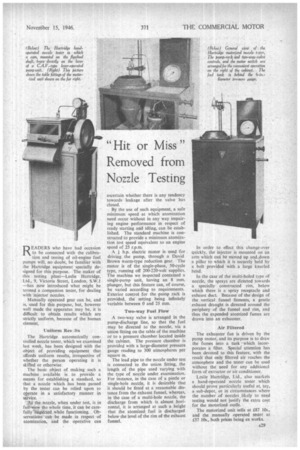"Hit or Miss " Removed from Nozzle Testing
Page 31

If you've noticed an error in this article please click here to report it so we can fix it.
173 EA DERS who have had occasion n. to be connected with the calibra tion and testing of oil-engine fuel pumps will, no doubt, be familiar with ihe Hartridge equipment specially designed for this purpose. The maker of this testing plant—Leslie Hartridge, Ltd., 9, Victoria Street, London, S.W.I —has now introduced what might be termed a companion tester, for dealing with injector nozzles.
Manually operated gear can be, and is, used for this purpose, but, however well made the apparatus may be, it is difficult to obtain results which are strictly uniform, because of the human element.
Uniform Resits
The Hartridge automatically controlled nozzle tester, which we examined last week, has been designed with the object of providing equipment that affords uniform results, irrespective of whether the person operating it is skilled or otherwise.
The basic object of making such a machine available is to provide a means for establishing a standard, so that a nozzle which has been passed by the tester can be relied upon to orrate in a satisfactory manner in service.
:A4 the nozzle, when under test, is in fullhview the whole time, it can be carefullyhhbpëLed while functioning. Observaticins'cah• be made in respect of atomization, and the operative can
ascertain whether there is any tendency towards leakage after the valve has closed.
By the use of such equipment, a safe minimum speed at which atomization need occur without in any way impairing engine performance in respect of ready starting and idling, can be established. The standard machine is constructed to provide a minimum atomization test speed equivalent to an engine speed of 25 r.p.m.
A h.p. electric motor is used for driving the pump, through a David Brown Worm-type reduction gear. The motor is of the single-phase, 50-cycle type, running off 200-220-volt supplies. The machine we inspected contained a single-pump unit, having an 8 mm. plunger, but this feature can, of course, be varied according to requirements. Exterior control for the pump rack is provided, the setting being infinitely variable between 0 and 25 mm.
Two-way Fuel Flow
A two-way valve is arranged in the pump-discharge line, so that the fuel may be directed to the nozzle, via a union fitting on the table of the machine or to a pressure chamber located inside the cabinet. The pressure chamber is provided with a large-diameter pressure gauge reading to 300 atmospheres per square in.
The lead pipe to the nozzle under test is connected to the union fitting, the length of the pipe used varying with the type of nozzle under examination. For instance, in the case of a pintle or single-hole nozzle, it is desirable that it should be fitted at a reasonable distance from the exhaust funnel, whereas, in the case of a multi-hole nozzle, the discharge from which is almost horizontal, it is arranged at such a height that the atomized fuel is discharged below the level of the rim of the exhaust funnel.
In order to effect this change-over quickly, the injector is mounted on an arm which can be moved up and,down a pillar to which it is securely held by a bolt provided with a large knurled head.
In the case of the multi-holed type of nozzle, the sprays arc directed towards a specially constructed rim, below which there is a spray receptacle and exhaust duct. Because of the design of the vertical funnel fitments, a gentle exhaust draught is directed around the periphery of the funnel and rim, and thus the expended atomized fumes are drawn into an exhauster.
Air Filtered The exhauster fan is driven by the pump motor, and its purpose is to draw the fumes into a tank , which incorporates a filter. Special attention has been devoted to this feature, with the result that only filtered air reaches the atmosphere and the tester can be used without the need for any additional form of extractor or air conditioner.
Leslie Hartridge, Ltd., also markets a hand-operated nozzle tester which should prove particularly useful at, say, a sub-depot, or in circumstances where the number .of nozzles likely to need testing would not justify the extra cost ■ for the motorized outfit.
The motorized unit sells at £87 I0s., and the manually operated tester at £37 10s., both prices being ex works.




































































